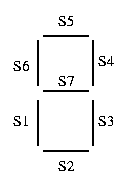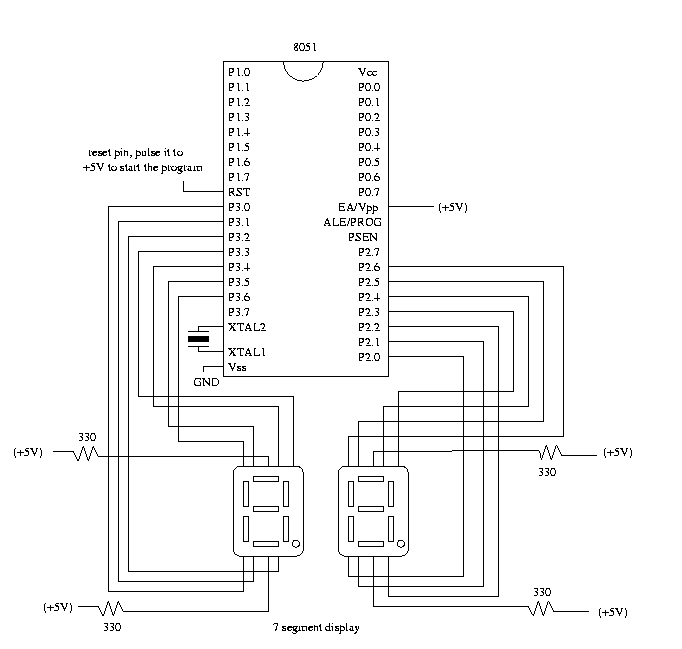Decimal Counter Using Two 7-segment displays and an 8051.
Introduction
The purpose of this lab is to implement a decimal counter which
counts from 0 to 99. You will have to write a C program for
the 80X51 micro-controller. You will then compile your C program
using C51 compiler and burn it unto an 8051 stand alone chip.
You will also have to do some wiring in this lab. The 8051 chip
requires some connections to function properly, and the 7-segment
displays need to be wired to the 8051. Schematics are
provided below.
Before you can write your C program, you have to understand how the
7-segment displays work. The 7-segment displays used in the lab
are the LSD5061-11 display. Each of the segment corresponds to a
pin (see below for the pinout). In order to light up a particular segment,
it's pin must be set to 0V. Since these pins are connected to the
8051, we simply set the corresponding pin on the 8051 to '0'. To
turn a segment off, the pin must be set to 5V. This is done by setting
the corresponding pin on the 8051 to "1".
Instead of going through each of the seven pins and setting them to
'1' or '0' each time we want to display a number, we will use a
lookup table unsigned char LookupTable[11] = { }. The
location of the entry in the table corresponds to the correct pin
settings to display that number. Simply, LookupTable[0] returns the
correct pin settings to display a "0" on the 7-segment display.
Now we have to figure out the correct entries into the table. We
know that in order to display a "0" on the 7-segment display we
need to turn on segments s1, s2, s3, s4, s5, and s6. To turn a
segment on, we set the corresponding pin to "0". Segment s7
will need to be turned off. To turn off this segment we set the
corresponding pin to "1". Therefore, the pins will need to be
assigned the following values:
P2^0 = 0;
P2^1 = 0;
P2^2 = 0;
P2^3 = 0;
P2^4 = 0;
P2^5 = 0;
P2^6 = 0;
P2^7 = 1;
P2^8 = 1; //don't care what this value is since it is not used
We set it to 1 because the 8051 pins are by default 1
The bit pattern desired is 1100 0000 (remeber that pin 8 is the
highest bit). We then convert the values into hexadecimal 1100 -> C and
0000 -> 0. We fill in the table with this value 0xC0. The "0x" is
needed before the actual value to indicate to the compiler that it
is a hexadecimal value. Now when we call LookupTable[0] it will
return the proper configuration to display a "0" on the 7-segment
display. You will need to fill in the rest of the values (1-9).
LookupTable[10] will indicate an error has occured, at this
location segment s7 will be on, the remaining segments will
be off. (If you want, you can also look at the 7-segment display
datasheet.)
| Segment number |
LSD5061-11 Pin number |
8051 pin number
(One's place display) |
8051 pin number
(Ten's place display) |
| s1 |
pin 1 |
P2.0 |
P3.0 |
| s2 |
pin 2 |
P2.1 |
P3.1 |
| s3 |
pin 4 |
P2.2 |
P3.2 |
| s4 |
pin 6 |
P2.3 |
P3.3 |
| s5 |
pin 7 |
P3.4 |
P2.4 |
| s6 |
pin 9 |
P2.5 |
P3.5 |
| s7 |
pin 10 |
P2.6 |
P3.6 |

Assignment
In this lab :
- You will implement a decimal counter using the
C programming language for the 8051 micro-controller
and display the count (0 to 99) on two 7-segment displays.
- You will then burn your program on the 8051.
- Make necessary connections the 8051 chip and
the two 7-segment displays.
- Verify the correctness of your circuit.
Apparatus Required
- 330 resistors (4)
- 7-segment display (2)
- 5V power supply
- 8051 chip
- 12MHz crystal (clock)
Schematic

Program
#pragma SMALL DB
#include
/* P0, P1, P2 and P3 are predefined port names and are bit addressable */
unsigned char SetDisplay(unsigned char value){
unsigned char LookupTable[11] = { 0xC0, ... };
/* check to see if "value" is in bounds,
if not return an error */
if( ) {
/* return appropriate value */;
}
else {
/* return error value */;
}
}
/* Delay function */
void delay() {
int i, j;
for(i=0; i<1000; i++)
for(j=0; j<100; j++)
i = i + 0;
}
void main(void){
unsigned char count = 0; /* value held in one's place */
while(1) {
/* determine and display the one's place */
/* determine and dipslay the ten's place */
/* update the counter (remember to keep it within bounds)*/
delay();
}
}
Procedure
Hardware
- Wire up the circuit as shown in the schematic.
- Pinouts are also available:
- 8051
- 7-segment display
Software
- Map your network drive to P:\\Peart\cs122
- Run the batch file cs122.bat
- Create a directory for your program on the C: drive (i.e. C:\Temp\counter)
- Using a text editor (i.e. notepad, etc...) type in the
program provided and add any necessary code to your program.
- Compile your program to generate object file count.obj
c51 count.c
- Link the object file to create your executable file count.omf.
bl51 count.obj to count.omf
- Create a hex file, count.hex, used to burn your
program unto the 8051 chip
oh51 count.omf
- Copy your hex file to a floppy
copy count.hex A:\count.hex
Burning A Chip - Programmer: MP-51
- Place the chip to be programmed on the slot making sure
that the correct side is up
- Use the arrow keys on the keyboard to choose options
- Choose Type -> 51Controller -> PC89C52U
- Choose File -> Load and enter the pathname of your hex file
(i.e. A:\counter.hex)
- Choose Command -> Program -> DeviceMemory -> Program Device Memory
- The chip will be programmed. Remove it from the chip from the
socket. It is now ready to be plugged into your board.
Testing Your Program
- Make sure that your chip has the power and ground
connections as specified by the schematic.
- Connect pin 9 to ground.
- Supply power to your board (make sure the power supply is
set to 5V, if it is higher you will damage the 8051
chip.)
- Pulse pin 9 to power then return it to ground.
- Your program should now be running. Test to see if it is
working correctly.
- If your program is not working as desired you will have to
modfiy your program, then compile and download unto the
chip again.

